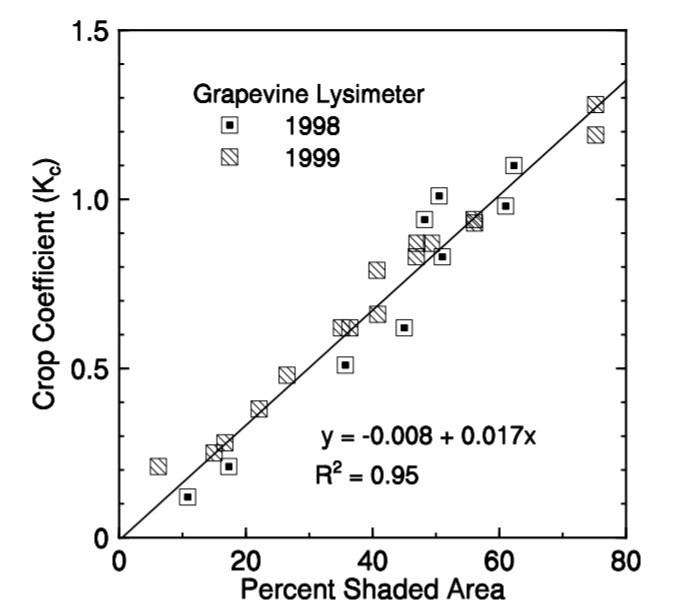Summary
This log covers lessons learned from measuring soil moisture in the vineyard, how to estimate daily water need of plants, calculate irrigation time, and how to apply that to an accurate automated irrigation system.
Lessons from soil moisture
Until harvest, I maintained the soil moisture at a level to keep my vineyard happy. Immediately after harvest I reduced the daily irrigation amount, and as a result moisture levels drop/sensor resistance increases.
The rain event in September only interrupted the drying trend for a week. The sensor at 5 feet (below active root zone) triggered to the rain water almost immediately, showing that it drains through the soil to levels beyond reach of the vines.
In contrast, increasing the daily irrigation quantity (starting Oct 10) causes the soil moisture to slowly increase. After stopping irrigation, the soil slowly dries.
Key take-aways:
1. While under irrigation, soil moisture changes slowly (week-by-week, rather than day-by-day). If you replace the daily amount of water used by the vines, the moisture will remain constant.
2. Soil penetration depth of irrigation can be managed by water quantity /irrigation event
3. Rain drains deep fast, not all rainwater will benefit the vines as it will quickly reach levels below the root zone.
4. It's better to wait for rain to flush out soil salinity than using irrigation water. It will take A LOT of irrigation water to flush out salts from the soil.

Determine daily water use and irrigation time
We need to estimate the day water consumption use of a plant in order to irrigate the right amount to replenish that. In agriculture, ETo (evapotranspiration) data is widely used for that purpose.
The following equation can be used to calculate vine water requirements:
ETc =ETo x Kc
where ETc = vineyard evapotranspiration, ETo = reference evapotranspiration and Kc = crop coefficient. The above equation will give water requirements in inches or mm (one acre inch = ~ 27,500 gallons per acre) (one mm covering one hectare = 10,000 L)
Below is an example of ET0 values this year in Temecula California.

The crop coefficient (Kc) is an indication of how much light is intercepted by the plant canopy, it is dependent on the seasonal growth stage and the trellis design. I determined the Kc by measuring the canopy state at noon.
The spacing for each vine in my vineyard is 6' x 9', or 54 square feet for each vine. The measured canopy shade was 2 feet =22%.
Kc = 0.0017 x 22%= 0.375, where 0.0017 is the slope factor found for grape vines (source: Williams and Ayars, 2005).

Irrigation Calculation Example:
For an ETo of 0.25 inch, water consumption of a grape vine in my vineyard was:
ETc =0.25 x 0.375 = 0.0938
Daily use per acre = 0.0938 x 27,500 gallons per acre = 2,578 gallons
At 9 x 6 feet spacing: 806 vines/acre = 3.2 gallons/vine/day
Irrigation time:
I use 2 drippers of 1 gallon/hr per vine.
Required irrigation time for 3.2 gallon: 3.2 / 2 x 60 = 96 minutes
How to get your ETo data
The best way to get ET data is using a Lysimeter. This is not for everyone though, it is basically a small vineyard on a big scale. Or you can use a pan filled with water and measure how much evaporates every 24 hours.
As an alternative, ET0 can be calculated using multiple valuables obtained from a weather station that is placed in the reference crop (grass): solar intensity, temperature, wind speed, air pressure, and air humidity.
For very rough ET estimates, you can use temperature with the Blaney-Criddle formula: ETo = p (0.46 T mean +8)
ETo = Reference crop evapotranspiration (mm/day) as an average for a period of 1 month
T mean = mean daily temperature (°C)
p = mean daily percentage of annual daytime hours
There are many on-line weather stations that provide localized ET0 data. One source for wine areas is www.winebusiness.com
In California, ET0 data can be obtained on-line, localized by ZIP-code: www.bewaterwise.com/icp/IRWD.pdf
Luke Beno wrote code for the Electric Imp to get the California data, and published step-by-step instructions: https://hackaday.io/page/1281-how-to-get-ca-eto-data-with-electric-imp
Accurate Automated Irrigation
Irrigation based on ETc estimates is not accurate as it assumes ETo is the same for the whole ZIP code area, and crop coefficient varies over the season with canopy development and management (like removing suckers and hedging).
Based on ETc, you can have a reasonable estimate of the day-to-day water need of your plants.
ET can show considerable variation, this season I noted values between 0.04 and .29.
Daily ETo updates will provide good granularity for determining daily irrigation quantities.
Adding (slow changing) soil moisture in the irrigation decisions, helps adjust irrigation to proper values. If you under-estimate the irrigation time, average soil moisture will slowly decrease, and vice versa.
Rain has shown in my vineyard as event where soil moisture changes relatively fast.
Based on on a combined ETc / soil moisture system for irrigation decisions, rain can be handled in two ways:
1. Stop irrigation until soil moisture has returned to value before rain
2. Subtract rain from ETo (example: ETo of 0.25 inch, 0.1 inch rain > new ETo = 0.15)
As with all projects, you can never have enough data. Irrigation takes time to figure out, in my case a full growing season is probably not enough. My observations are specific for the soil (decomposed granite) and climate of my vineyard in Southern California. Results may vary, but my hope is that this information will inspire to do smart things with (agricultural) irrigation.
 Reinier van der Lee
Reinier van der Lee
Discussions
Become a Hackaday.io Member
Create an account to leave a comment. Already have an account? Log In.